Please use the following link to download the April 29, 2023 issue of the syəcəb
Category: Tulalip News
Indian Boarding School survivors share heart breaking experiences of forced assimilation
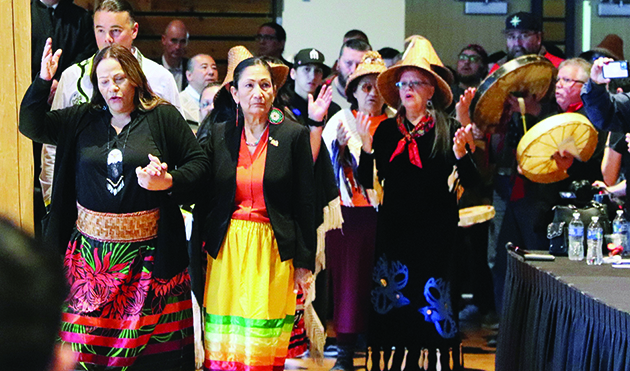
“We were all silenced. We don’t tell-all because we can’t tell all – because we might get a spanking. There was a lot of things I’ve seen, a lot of things I heard, a lot of things I don’t want to remember. We kept our secrets all this time. We don’t talk about it; we should talk about it. It’s okay to heal, we are not healed yet. I’m 99 years old and I’m still healing yet. It’s hard. It’s very hard.”
-Ernestine Lane, Lummi Nation
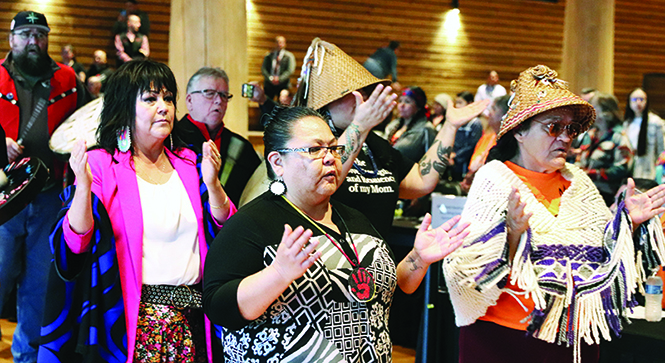
By Kalvin Valdillez, Tulalip News
In the late 1800’s, the US government made it their mission to erase the cultural identity of the Indigenous population by establishing boarding schools throughout the country. The official slogan for the Civilization Fund Act was ‘kill the Indian, save the man’. Children as young as three were forcibly removed from their families and tribes to attend these horrific assimilation academies. And if the children spoke their ancestral languages or practiced any of their traditions at the boarding schools, they were punished harshly and faced physical, emotional, and mental abuse. These institutes continued with these practices well into the sixth decade of the nineteenth century.
Resilient is a word that this current generation of Native people identify with because they are actively putting in work to revitalize and recover their languages, dances, songs, and traditional way of life. And after decades of attempts, from both religious and governmental institutions, at demonizing our people and practices, we are still here, and we are still standing strong.
Many of today’s Indigenous activists and cultural bearers are quick to credit the older generations who experienced the atrocities committed by the boarding schools, and who held strong and passed on their traditions to the next generations. For Tulalip, there are several prime examples of resilient tribal members who preserved the culture despite harsh assimilation efforts. One such individual is always held in high honor for the sacrifices she made to ensure that the history and traditions of the sduhubš people are accessible to their future generations for many years to come, and she is none other than Harriette Shelton-Dover.
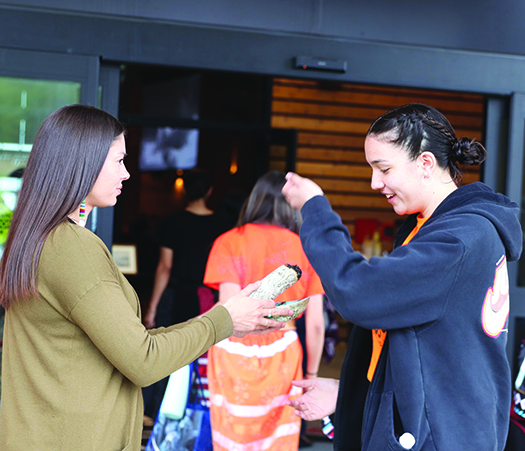
On the morning of April 23, the reason why many Coast Salish children bravely endured lashings, beatings, or solitary confinement, and the reason why many children were laid to rest at a young age, was on full display at the Tulalip Gathering Hall. The reason they made those sacrifices could be seen on the button-designed shawls and vests, the cedar-woven hats and headbands. Those sacrifices could be heard on the elk and deer skin hand drums, and in the voices of their descendants who utilized their ancestral language, in both song and prayer. The sacrifices were present in every dance step, in each bite of salmon during the lunch hour, and through the act of smudging with sage bundles every time someone walked through the doors of the Gathering Hall. Those sacrifices were made by young children who kept the cultural fire burning in the darkest of times.
The price those elders and ancestors paid did not end with corporal punishment at the boarding schools. Over time, due to the threat of those punishments, they learned to hold their emotions in, which resulted in heavy baggage that was also passed down their lineage. And though most boarding schools have been disestablished, the trauma wounds they caused are still very much exposed and present in every Native community throughout North America.
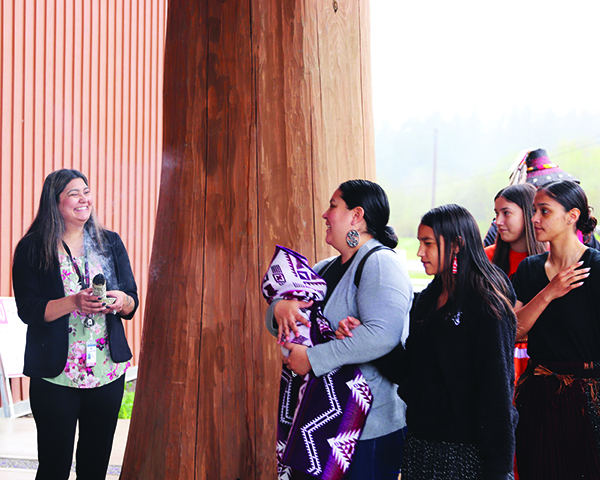
Until recent years, the history of Indian boarding schools remained widely unknown to the general population. The first step in healing those trauma wounds was simply making people aware of the damage caused and the lives lost during the boarding school era, as well as getting the federal government to acknowledge their role in the attempt of cultural genocide.
In 2021, the first Native American to serve as a US Cabinet Secretary, Deb Haaland (Laguna Pueblo), launched the Federal Indian Boarding School Initiative to investigate what took place at these schools by reviewing records and speaking to the tribal nations that were affected by Civilization Fund Act. The results of that investigation, released in May 2022, show that between the years of 1819 and 1969, the US operated or supported 408 boarding schools across 37 states, along with at least 53 burial sites for Indigenous children.
In the following months, Secretary of Interior Haaland and Bryan Newland (Bay Mills Indian Community), the Assistant Secretary of Indian Affairs, organized a yearlong journey across the nation, known as the Road to Healing Tour. The goal behind the tour is ‘to connect communities with trauma-informed support and facilitate collection of a permanent oral history’.
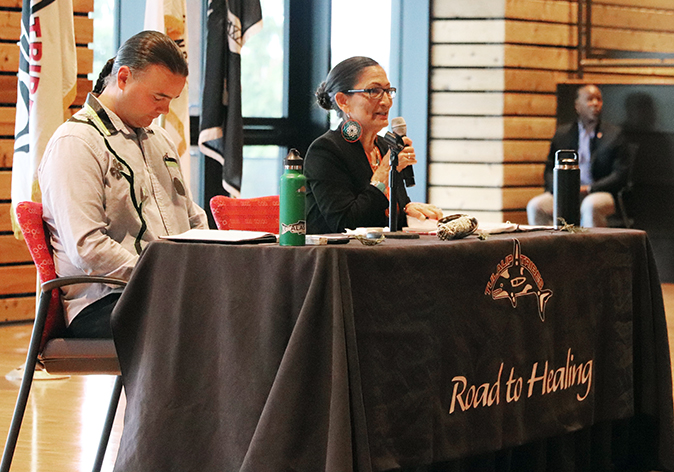
The Road to Healing made its sixth stop of the tour at the Tulalip Gathering Hall. In addition to the 200 or so tribal members in attendance, a group of professionals from Indian Health Services, whose expertise is in trauma-informed care, were at-hand to support the boarding school survivors and their decedents throughout the day.
Secretary Haaland was escorted to the front of the Gathering Hall by a group of Tulalip singers as they opened the ceremony with the sduhubš welcome song, also known as Harriette Shelton-Dover’s song. After blessing all four corners of the longhouse-style hall, cultural bearer Glen Gobin shared a brief history of boarding schools at Tulalip.
He shared, “There were three phases of the boarding school. Father Chirouse came shortly after the treaty signing, he set up a school at the mouth of Quil Ceda. Then he moved it down towards Priest Point and actually built a school there – that’s why it’s called Priest Point. And as our children passed away, he started a cemetery there also. I was doing research and I saw that my grandma’s sister, age 6, was one of those who died and is buried at that cemetery.
“And then, I believe it was in the late 1860’s, the Sisters of Providence petitioned the government to start a school. That school was across the bay where Mission Cemetery is today – and that’s why there is a cemetery there. As the children passed away, they were buried around the school grounds.
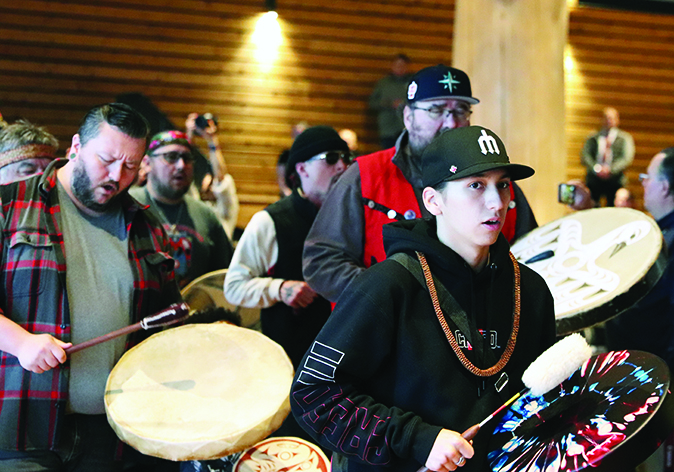
“That [school] burned down in the late 1800s and then the government took the program back and said, ‘we’re going to run this ourselves now’. And so, in the early 1900s, the boarding school was developed – that was ran like a military camp. And as we heard many of our elders talk throughout the years, what they knew, or witnessed, or what our grandparents told them – was about the constant marching, the constant inability to speak their language, the constant inability to see their family when they wanted to, because they were taken away and brought to the schools to civilize them.”
Following introductions by both Deb Haaland and Bryan Newland, they opened the floor for the survivors, and their descendants, to share how they were affected by the Indian boarding schools.
Virginia Bill, daughter of survivor Lottie Sampson (Swinomish/Upper Skagit) stated, “When she got here to Tulalip, she did talk of having to be marched everywhere. She talked about that bell that would ring. I think it was in the 1980s, we were brought here to a ceremony to commemorate that bell. I found my mom sitting alone by herself, and I asked her what she was thinking. She said, ‘Thank God, that silence. No more will that bell tell me where to go, where to be’. I read some documents that said they were going to make Tulalip the Carlisle of the Northwest. I read some of the official papers, where the former priest that was here referred to our families as savages. When you read those articles, it breaks your heart. There are no commemorative plaques, no ribbons, there are no stories telling us about the success of our mothers and fathers – there is no ‘congratulations, you made it’.”
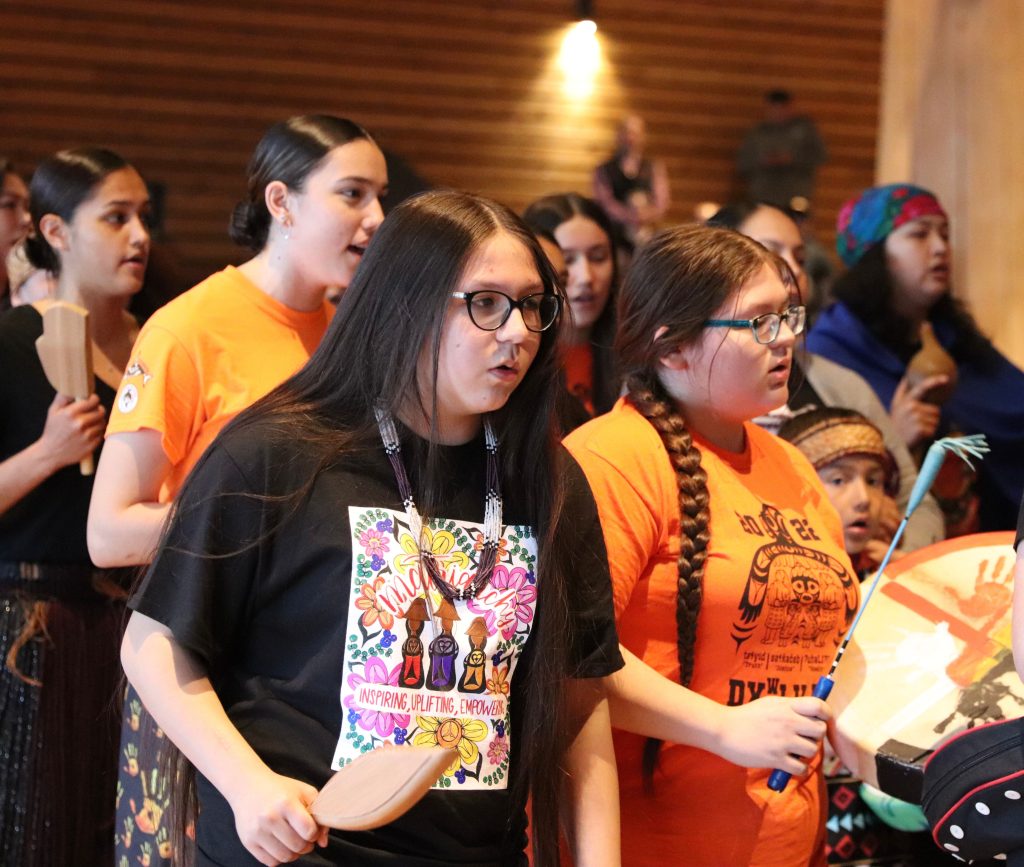
Boarding School survivor and Lummi tribal member, Jewell James, said, “My great-grandfather talked about how they would burn his tongue and torture him, and stick his tongue on frozen pipes outside during the winter every time he used his Lummi language. It was a real traumatic experience. My mother, when she was three, ended up at Cushman (Indian Hospital). And she battled with depression. There was no job or income or food on the reservation, so it was either Cushman or you starve. And she would always talk and cry about how at the age of three, they put her in the basement with the rats and blocked off all the lights. She’d always talk about how she had to hide in the corner and hope the rats didn’t get her.”
The tears were pouring as boarding school survivor Matthew War Bonnet Jr. (Lakota), recounted his boarding school experience. He said, “at nighttime, in the dormitories, the kids would cry because they were lonesome for their parents. Sometimes the priest who shared a little room off to the side, would get disturbed about that. He would come out with his belt, pick up a kid off the bed and whack them for crying. When you’re six years old and you see that, you get scared, you start holding things in.”
After about two hours and several testimonies, Haaland and Newland called for the first break, and a traditional Tulalip lunch was served to the people. During this time, they asked for all the media outlets to excuse themselves for the day. The following sessions provided the opportunity for more survivors to detail their experiences at the boarding schools, while delving deeper into topics that they were not comfortable sharing in front of the cameras. From what we gathered through social media, the event extended into the late Sunday evening. Important work took place, and the healing process began for many, as they opened up for the first time about the terrible things that occurred at the schools in a private and supportive setting.
Secretary Haaland expressed, “Your voices are important to me, and I thank you for your willingness to share your stories. Federal Indian Boarding School policies have touched every Indigenous person I know. Some are survivors, some are descendants, but we all carry this painful legacy in our hearts. Deeply ingrained in so many of us is the trauma that these policies in these places have inflicted. My ancestors and many of yours endured the horrors of Indian boarding school assimilation policies carried out by the same department that I now lead. This is the first time in history that the United States Cabinet Secretary comes to the table with the shared trauma – that is not lost on me. And I’m determined to use my position for the good of the people.”
She continued, “In Washington state alone, there were 15 boarding schools, leaving intergenerational impacts that persists in the communities represented here today. It is my department’s duty to address the shared trauma that so many of us carry. To do that, we need to tell our stories. Today is part of that journey – I want you all to know that I’m with you on this journey. I will listen, I will agree with you, I will weep, and I will feel your pain. As we mourn what we have lost, please know that we still have so much to gain. The healing that can help our communities will not be done overnight, but I believe very strongly that it will be done. This is one step among many that we’ll take together to strengthen and rebuild the bonds within Native communities that Federal Indian Boarding School policies set out to break. Those steps have the potential to alter the course of our future.”
April 22, 2023 syəcəb
Please follow the link for the April 22, 2023 issue of the syəcəb
Weaving together with Cedar Roses
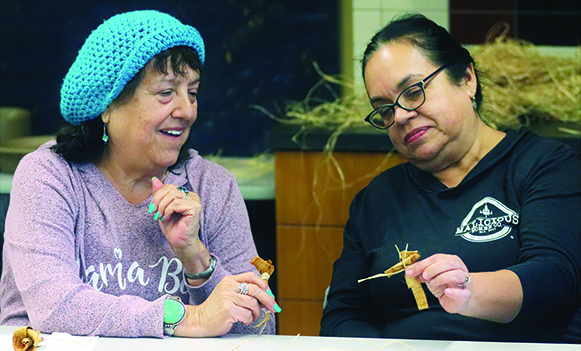
Indigenous Beginnings shares traditional teachings across multiple generations
By Micheal Rios, Tulalip News
When the Native-led, local nonprofit Indigenous Beginnings launched in July 2021, the mission was simple: to freely give and share traditional teachings through in-person, hands-on cultural workshops taught by inspirational knowledge keepers.
Created by Tulalip Court executive administrative assistant Stephanie Cultee, herself a Nooksack citizen and a dedicated employee of the Tulalip Tribes enterprise since 2008, Indigenous Beginnings has hosted 44 workshops thus far. Each intricately designed workshop is intended to help spread the cultural teachings of Coast Salish tribes, while sharing the diversity of knowledge from Native culture bearers in both urban and reservation-based settings.
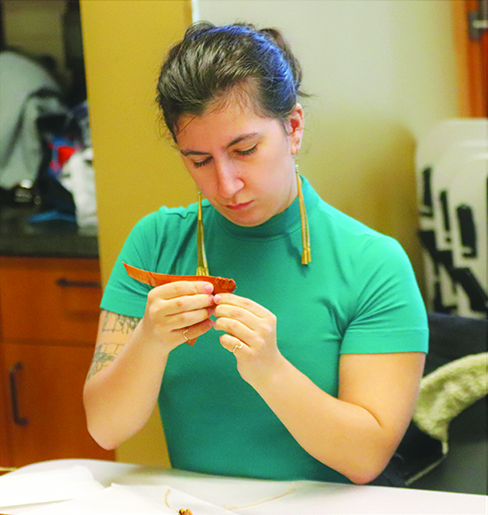
The culturally appropriate nonprofit continues to be dedicated to teaching tribal and nontribal participants how to sustainably harvest, prepare traditional foods, and how to weave, carve and otherwise transform natural resources into utility-filled items. Hosted events have included making delicious jelly from fireweed, harvesting devil’s club and mountain huckleberry, weaving cedar into baskets and headbands, carving canoe paddles, making traditional round drums, and even how to clean, fillet and smoke salmon. Workshops have primarily been led by Tulalip, Nooksack, Lummi and Quinault citizens.
“With Indigenous Beginnings, all of our workshops are for all ages,” explained Stephanie. “There was a whole generation that couldn’t practice or learn their ways from their grandparents because of the boarding school era. So for those older generations who want to learn, they can attend our workshops which is just as much designed for them as any adult or youth. This way we can not only keep our elders involved in their culture, but have them set that example for the young ones that it’s okay to ask questions and admit there’s always more to learn.
“I am from Nooksack and moved down here when I was 15-years-old,” she continued. “I have three daughters who are Tulalip, and I want them to learn their Tulalip heritage and Nooksack’s as well because they are descendants from Nooksack, too. I didn’t know much about my tribe, because I moved away when I was young, and I thought this could be a way that I could teach them the traditional ways of their people, while also learning myself.”
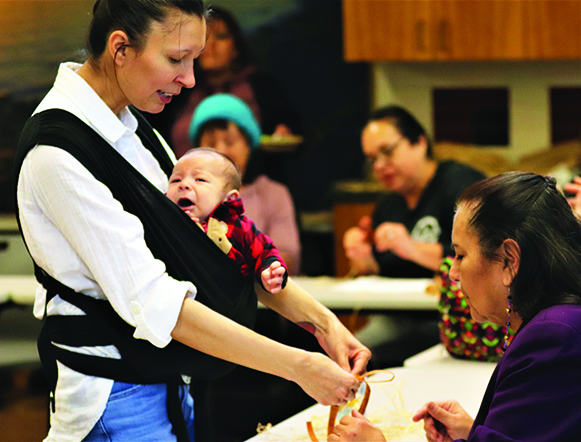
It was in that spirit of cultural understanding and community building that Indigenous Beginnings hosted an awe-inspiring workshop at the Hibulb Cultural Center centered on created cedar roses. Lushootseed teacher Maria Rios instructed the full classroom in the basics of cedar weaving 101, which included at times having her infant son Enzo harnessed belly side.
The diverse group of eager learners spanned multiple generations. They sat intently as Maria detailed how Coast Salish tribes believe the Creator gave their people cedar as a gift. Cedar was the perfect resource, providing tools, clothes, baskets and carvings in addition to having medicinal and spiritual purposes. After being harvested and stored for future use, the highly sought after golden inner bark is separated into strips and intricately shredded for weaving. The processed bark can then be used as a malleable material, similar to wool and other synthetic fibers, and crafted into baskets, clothing, or, as in this particular case, long-lasting roses.
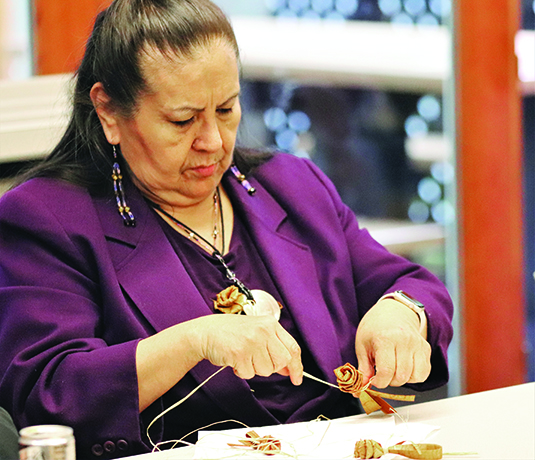
Among the workshop participants was Tulalip mother/daughter duo Carlotta and Cheylah. After receiving a few of the finer weaving pointers from Maria, they quickly found a groove and feverishly created a couple dozen cedar roses. Of course, in the traditional way, Carlotta gave away her first made rose to elder Rebecca Hunter.
“I’ve wanted to relearn how to make cedar roses for a long time now. I was originally taught by the late Tara Taylor over twenty years ago, but unfortunately I lost the teaching by not practicing enough,” shared Carlotta. “My daughter Cheylah is 13-years-old and kind of at the hardheaded phase, so I wasn’t sure if she’d want to come with me or not at first. But then she was so excited to join after I told her Miss Maria was the instructor. I’m so happy we got to participate and learn together. We had a lot of fun.”
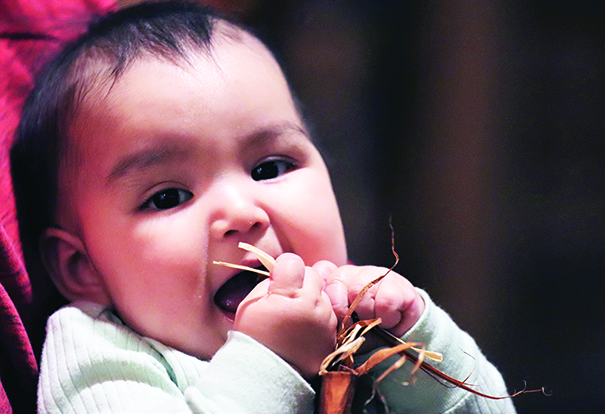
The memorable afternoon was filled with a type of whimsical family bonding that was once common place among tribal villages. With babies, teenagers, adults, and elders all sharing in a unified experience of weaving with yellow cedar. Some for the first time. Others for the first time in a long time. And still others who had only dreamed of one day having the opportunity to create cedar roses in a similar fashion as their ancestors once did.
Such is the case with Seattle resident Shyanne Steele of the Colville Confederated Tribes. She shared having memories of being a little girl and watching her grandma, also a language teacher, weave all kinds of items. When she came across a flyer for the cedar rose workshop on Facebook she jumped at the opportunity at attend.
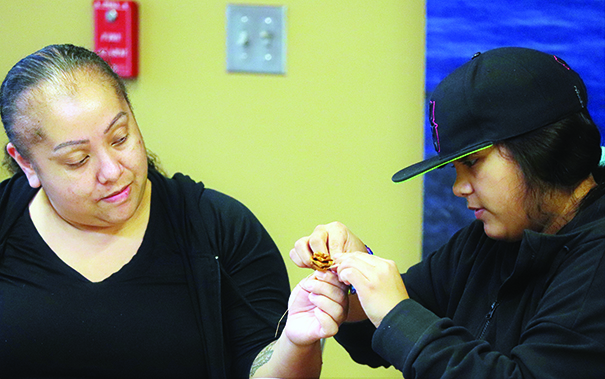
“Lately, I’ve been thinking a lot about how to get more connected with traditional art forms because it’s so difficult for me given my tribe is far away. Then, just a few nights ago, I actually dreamt about harvesting cedar,” said the 24-year-old University of Washington student. “Being able to attend and interact with so many welcoming tribal members here was amazing. It really grounded me to the teachings we have about cedar. Beyond being a super cool and strong material to work with, it’s been central to Indigenous life in this area for countless generations and really helps us connect with our ancestors.”
By bringing tribal citizens of different generations together in an atmosphere of learning and sharing, the Indigenous Beginnings cedar rose workshop allowed participants an opportunity to connect with Natives of neighboring tribes and form meaningful relationships based on shared interests and experiences.
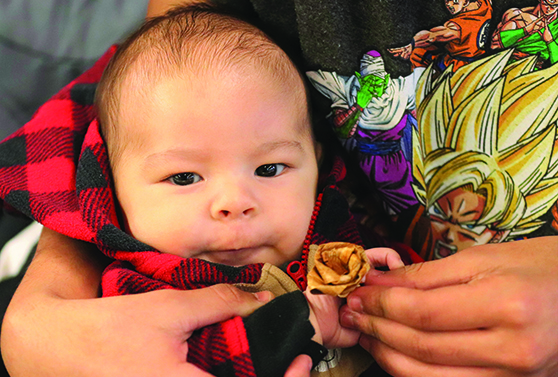
Whether it’s to learn new skills or refine existing ones, the active participation in our shared culture is how we help maintain a strong connection between the past, present, and future. Ensuring that important cultural knowledge and traditional knowhow is preserved and passed on to future generations.
Smoke Signals: Local teens use creativity to combat vaping
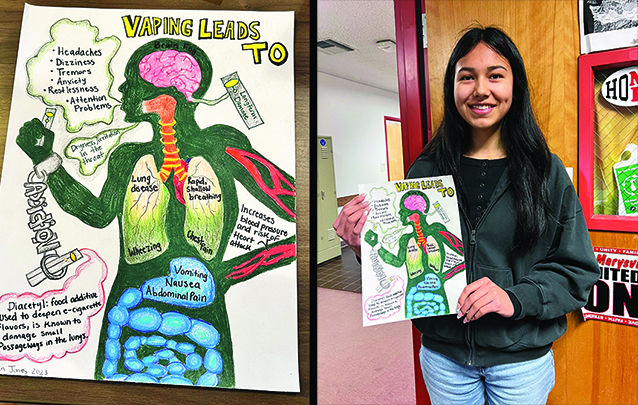
By Kalvin Valdillez, Tulalip News; photos courtesy of the Tulalip Community Health Department
This past February, the Tulalip Community Health (TCH) department announced a month-long art contest which was open exclusively to Native American students who attend either a middle or high school within the Marysville School District (MSD). Leading up to the contest, Community Health visited each of those Jr. and Sr. high schools and dropped some important knowledge on the tribal students about the dangers of vaping and smoking e-cigarettes.
After establishing trust with the students, to ensure their anonymity, the department learned some key details about the usage of the electronic nicotine sticks and ‘vape juice’ within the community – the how, where, and why.
TCH Community Resource Coordinator, Kelly Prayerwarrior, shared, “We created a safe space at the very beginning, and let them know that we are not going to tell people who said what, we just want to get an idea of what’s going on. And they opened up and told us that kids are smoking at school in the bathrooms, on the bus, and that they basically are smoking everywhere.”
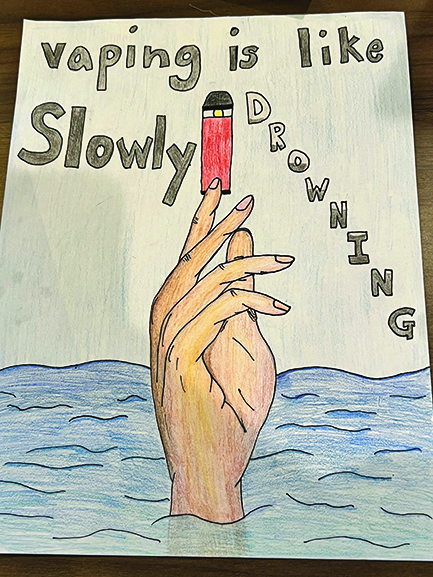
Over the past decade, numerous studies and reports were conducted by the likes of the CDC, FDA, the Surgeon General, and the American Lung Association about the relation to teens and vaping. An eye-opening statistic comes from the Truth Initiative about how widespread vaping has become in recent years. You may recognize the organization’s name from anti-vaping ads and commercials that air on both cable and YouTube. Their 2022 National Youth Tobacco Survey revealed that among teens nationwide, 42% admitted to using an e-cigarette within the thirty-day time period of which the study took place, while 46% of high schoolers confessed to vaping frequently.
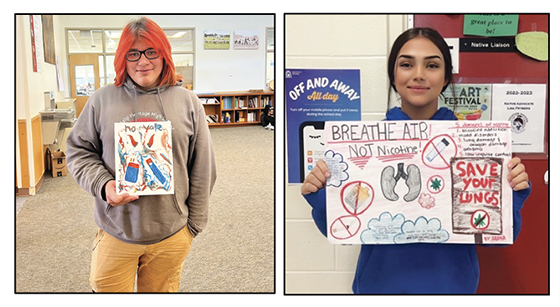
When asked about the appeal of vaping to the youth of our community, Kelly shared her insight and stated, “I think it’s because they are able to get ahold of it, they have easy access to it, it doesn’t smell. The kids who I talked to said that they are getting it from their family members who vape, and also their friends at school. I think it’s also the flavors and because it’s something new. And they’re seeing their community members and family members doing it, so they think it’s okay because everyone else is doing it.”
She continued, “It is an addiction. I see people walk around the store smoking their vape and many of them don’t know that they are inhaling lots of chemicals into their bodies, a lot of those same chemicals are used in cigarettes. There’s a term called popcorn lung, that’s caused from when the water of the vape gets into the lungs. It also fogs people’s mind, it raises their blood pressure, and it can cause irritability in the people who are addicted to it. When they don’t have it, they get irritable.”
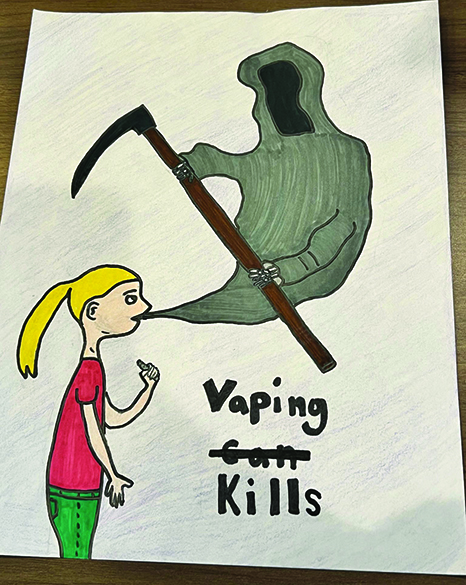
Upon chatting with the students about the harm vaping can cause an individual’s health and wellbeing, TCH announced the Anti-Vape Art Contest. The teens were asked to create a poster to combat the growing trend of vaping on the reservation and within the MSD. The kids were informed that the winner’s artwork would be the visual for a new campaign against vaping and that their work would be shared all throughout Tulalip and Marysville. Fifteen students took on the challenge and were motivated not only by creating a smoke-free environment locally, but also by a number of prizes including a Nintendo Switch bundle and Apple AirPods.
After much deliberation, due to the all the amazing artwork submitted, TCH announced the winner of the contest. Tribal member, Heaven Jones, brought home the grand prize thanks to her informative design which depicts all the negative effects that vaping has on the human body. Her impressive anatomy artwork pinpoints exactly where the damage of vaping takes place, and around her subject’s wrist are handcuffs. Heaven cleverly uses the technique of steganography to display the word ‘addiction’ as the links in the handcuffs.

“I’m proud of how the artwork turned out and I’m glad to know that people will learn from my poster,” expressed Heaven. “Hopefully it will help change how they think about vaping and realize what it could do and how it affects their body. I am very grateful. This contest was important to me because I have people in my family who vape, and I’ve seen them try to stop and seen how hard it is. What they have to go through when they aren’t vaping, and how they act, it makes me want them to be able to stop.”
Heaven shared that she also submitted four original pieces to the upcoming Native American Student Art Festival, that is organized by the Tulalip Education Division and the MSD Indian Education Department.

Lorina, Heaven’s mother, proudly stated, “She is a very talented artist. She really wanted to take part in this contest because of her family members and others in the community who do vape. She worries about everyone who does it.”
Heaven’s artwork will soon be plastered on the walls and hallways of several tribal department buildings in the near future, as well as at the Tulalip Administration Building, the Tulalip Boys and Girls Club, and various places throughout the MSD.
Said Kelly, “Everyone made really great art and I want them to get credit for participating in the contest. And I really wanted to highlight our winner because she put a lot of effort into her artwork and that’s the piece we are going to be using. It was heartwarming to see how many young leaders stepped up, because each one of them showed leadership by creating their art and making a statement with their work.”
April 15, 2023 syəcəb
Please follow the link for the April 15, 2023 issue of the syəcəb
Remembering March For Our Lives: Natives rally against gun violence
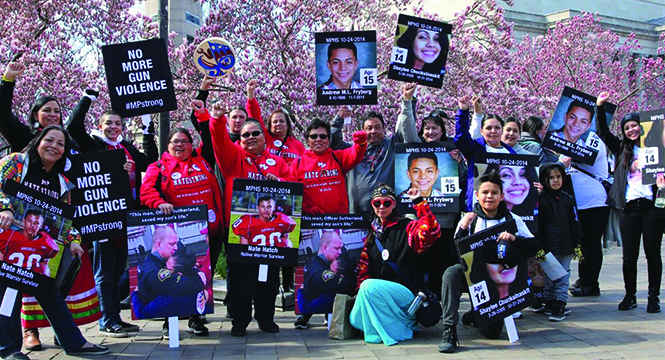
By Micheal Rios, Tulalip News
A grim reality of ‘returning to normal’ post pandemic shutdowns is the return of gun violence and school shootings consistently leading national news. This is especially distressing given we are only in April, yet there’s already been 147 mass shootings and an even more mind boggling 11,763 deaths attributed to gun violence in 2023*.
The Tulalip/Marysville community is still healing from the Marysville-Pilchuck High School shooting that changed the lives of so many forever on October 24, 2014. In the wake of recent media coverage and congressional spotlight being shed on the need for gun reform in this country, following deadly school shootings in a Nashville, Tennessee elementary school on March 27 and on the Michigan State University campus on February 13, we at Tulalip News thought it pertinent to revisit a history making trip to Washington, D.C. by a delegation of tribal members intent on making their voices heard.
The following was originally published in March 2018:
When the Tulalip Tribes Board of Directors passed a motion to support the March for Our Lives event in Washington, D.C., they followed through by sending a delegation of twenty individuals to support the Tribe’s national efforts to stop gun violence, specifically to put an end to mass shootings.
The Tulalip delegation was comprised of those most affected by the Marysville-Pilchuck High School shooting; the families of victims and survivors, along with a support group of community members. With a heartfelt message that could only come from those who have known great loss and tragedy created by gun violence, this normally private and reserved group visited Capitol Hill and advocated for gun-law reform.
When it comes to potentially saving innocent lives, the silence was broken so that the families could speak their truth, giving voice to those who couldn’t be there in person, but were undoubtedly there in spirit.
Mothers of MPHS shooting victims, Lahneen Fryberg, Lavina Phillips and Denise Hatch-Anderson shared their story and experience with gun violence, then advocated for stronger gun legislation first to representative Suzan DelBene, U.S. Congresswoman representing Washington’s 1st District. Then they shared with the office of Rick Larsen, U.S. Representative for Washington’s 2nd congressional district.
Next up was the office of senior U.S. Senator from Washington, Patty Murray. Then they met with legislative aides to Maria Cantwell, junior U.S. Senator from Washington.
“Gun violence is a topic of national concern. Our entire community was devastated in varying ways, whether you were directly or indirectly effected by the Marysville-Pilchuck shooting, it hurt deeply,” said Deborah Parker, who coordinated the day on Capitol Hill. “The families most affected by gun violence were able to speak out against the violence occurring nationwide.
“For many of the families who lost a loved one, the sentiment was consistent – it felt like it happened yesterday. The pain was real and the hurt pervasive. Our families who have suffered the greatest loss of their lives have a powerful voice and should never be silenced. As difficult and painful as it was for our families to bring forward their devastating memories, they did it. They spoke eloquently and candidly to U.S. government representatives about their experience with gun violence while offering policy solutions.”
Keeping their momentum, the Tulalip delegation made their way to the set of The American Indians’ Truths radio show for WPFW-FM hosted by Jay Winter Nightwolf. Again, the families shared their truth. Speaking on her experience was also Keryn Parks, a seventeen-year-old student who was forced to bear witness to the MPHS shooting.
“I was hesitant to even speak and share my story,” expressed an emotional Keryn. “Nothing happened to me physically and I do feel tons of guilt that nothing did. Maybe one of these moms would have their baby still with them if I sat somewhere else. It was a huge weight off my chest to speak and let everyone know how I feel for them. These mommas need all the loving, healing words they can take.
“As a group, we were so strong and powerful anywhere we went today, and that was felt by everyone who listened to us. It was a day of reopening wounds none of us wanted or even thought we were going to reopen. It was powerful and real. Above all else it was healing.”
The final destination on their Capital Hill visit was to the Embassy of Tribal Nations. Though it was last stop, it may have been the most impactful as the three moms, Lahneen, Lavina and Denise, shared details of their experience they had never shared before. Tears flowed from everyone in the room who sat in absolute awe of what was being said.
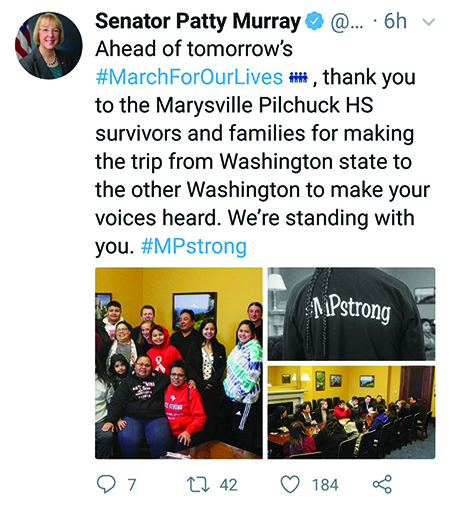
Amongst those who listened was Jackie Pata, Executive Director of the National Congress of American Indians. She stated afterwards, “My life has been forever changed by these Tulalip families. They have exhibited so much courage and strength to come forward and share their story. I will not forget them in the work I do.”
“Being there, with the families, was powerful and extremely healing,” said Matt Remle, who accompanied the families and supported them with his spiritual leadership. “Privately, over the years, I have shed many tears over what happened, but this was perhaps the first time that I was able to be with others and openly cry. Mostly what I took away from them is their bravery and courage. I don’t know much, but I do know that we simply need more love and compassion for each other, to support and give of ourselves to help others. That’s not politics, that’s living how we were meant to be.”
Being an effective advocate for legislative change, such as laws that can make a significant impact at reducing gun violence and putting an end to mass shootings, requires building strong relationships with our members of Congress and their staff members. It is important to use every opportunity to reach out and maintain these relationships. The Tulalip delegation did an admirable job honoring their loved ones lost to gun violence, while advocating for gun law reform.
“This Capitol Hill trip was for those families to voice their concerns and find healing in the process,” added Deborah Parker when the day’s itinerary came to an end. “It was a blessing to witness the transformation of everyone who took this journey. The mothers, and their support network, stood together for their truth while seeking justice. None of us would ever want this type of violence to happen to anyone else. It was clear, gun violence must stop.”
*source Gun Violence Archive, April 12, 2023.
Running the Mill Town Marathon
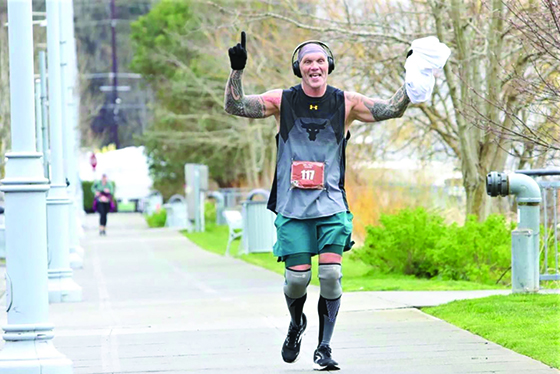
By Micheal Rios, Tulalip News; photos courtesy Teresa Jira & Lynn Bedient
The marathon, a 26.2 mile race, is one of the most challenging physical activities a person can undertake. It requires months of intense training, discipline, and perseverance to complete. Despite its difficulty, millions of people around the world take on the challenge each year. Remarkably, however, just 0.05% of the United States population has completed a marathon, which makes the achievement of completing one nothing short of impressive.
Preparing for a marathon is a grueling process that requires a tremendous amount of dedication and hard work. Runners must carefully plan out their training schedules, which can involve running several miles a day, multiple days a week, for several months leading up to the race. They must also cross-train and work on strength and flexibility to avoid injury and build endurance.
But the physical aspect of training is just one part of the process. Mental preparation is also crucial. Many runners must push through moments of doubt and discomfort during long runs, and they must learn to manage their nerves and anxiety leading up to the race. It takes a strong mindset to stay committed to the training plan and stay motivated to push through the pain.
The kind of strong mindset necessary for such a grueling task is what Sargent Jeff Jira is known for. As a peacekeeper with the Tulalip Police Department for over twenty years now, Sgt. Jira understands well the importance of self-discipline and practical goal-setting. A few months back, he shared that Tulalip’s own marathon man, Tyler Fryberg, sparked a fire within him to run his very first marathon.
At 52-years of age, Sgt. Jira underwent four months of prep work and stamina building in order to get his body primed to compete in April’s Mill Town Marathon.
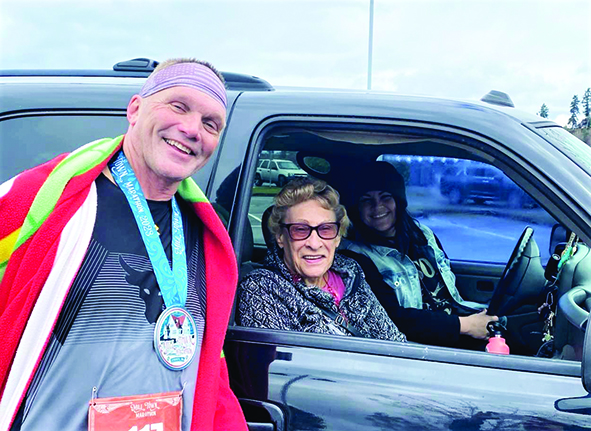
Formerly the Heroes Half, then the Everett Half, before its latest rebranding as the Mill Town Marathon, this local running course is operated by Snohomish Running Company. This particular course starts and finishes at Marina Park in the Port of Everett, running along the Everett waterfront and over the historic SR-529 drawbridge into south Marysville.
Race day yielded temperatures in the low 40s and scattered rain showers, yet the horde of runners who waited anxiously for the 7:00am start to the full marathon were undeterred. Including Sgt. Jira in his finest running gear.
After the starting gun fired, he set off with his fellow runners on a personal history setting journey. The first few miles are often the easiest, as adrenaline and the excitement of the crowd carry the runners forward. But as the race progresses, the physical and mental challenges become more intense. The body aches, the legs feel heavy, and the mind begins to question whether it can continue. But runners must push through the pain, drawing on their months of training and their inner strength to keep going.
As Sgt. Jira approached the marathon’s midpoint, near Ebey Waterfront Park, his face beamed with happiness and he smiled at the cohort of family and friends who braved the early morning elements to cheer him on.
The final stretch of the marathon is perhaps the most impressive. After running for more than 20 miles, the finish line finally comes into view. The crowd cheers, the adrenaline surges, and the runner finds one last burst of energy to sprint towards the finish. The feeling of crossing the finish line is indescribable, a moment of pure joy and accomplishment that makes all the pain and sacrifice worth it.
After a whopping 5 hours and 45 minutes of nonstop running Sgt. Jira crossed the finish line. He was greeted with a shiny new medal and another burst of excitement from his family. Shortly thereafter he posted to Facebook “I may have yelled a few times like David Goggins, “You don’t know me son!” along the way. It was 40 degrees, raining and my feet were wet, but it all comes down to mind over matter. Feels absolutely awesome to complete my first marathon at age 52! Special thanks for my cheer crew.”
In addition to the intense physical and mental challenges of the race itself, running a marathon has also become a popular way for runners to raise money for charitable causes. Many runners use the event as a platform to raise awareness and funds for important causes such as cancer research, poverty, or environmental conservation. By running a marathon, these individuals are not only challenging themselves, but they are also making a positive impact on the world.
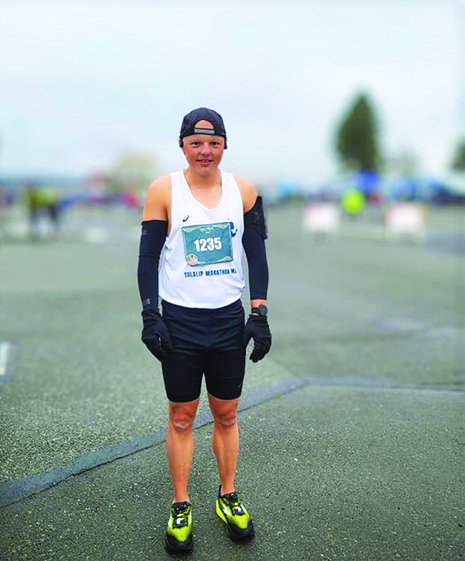
alive as a Native American today.” -Tyler Fryberg
Such is the case with Tulalip Marathon Man, Tyler Fryberg. He’s well known for running for causes like to raise profits for Leah’s Dream Foundation and inspiring more participation in the Special Olympics. He continues to strive to influence those around him, like Sgt. Jira, to take up running as not just a way to keep both the mind and body healthy, but also as a means to connect to previous generations.
“When I run, I feel the Native Americans before me,” he said in a previous interview with Tulalip News. “They did not have cars at one time, so they didn’t just run for a sport like I do today, but also to get food for their families, to get wood, and other [necessities]. Sometimes I feel like I am talking to someone who is not there on my runs. And I believe it’s the ancestors who lived before me. I feel like they would be proud of me for keeping running alive as a Native American today.”
Tyler’s Mill Town marathon participation came in the form of the half-marathon, which for him is something akin to a 13.1 mile sprint. The always inspiring 30-year-old ran a blistering pace and finished in 1 hour – 52 minutes – 48 seconds on the time keeper’s clock. He shared that he set a personal best at running the initial 10k section of the race in just 47 minutes.
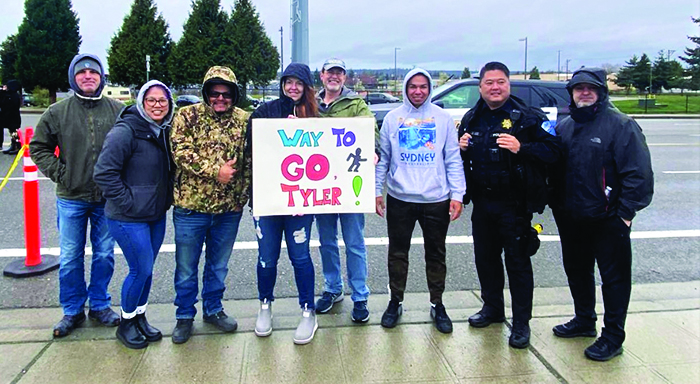
“So, what is next for the Tulalip marathon man? I am now going to be training for track season. Both 800 meter and 400 meter races…and getting better at javelin,” said Tyler. “Next year I will be running the Mill Town half-marathon again. I already have it on calendar.”
From the months of training to the intense physical and mental challenges of the race itself, running a marathon for the first time ever like Jeff Jira or a half-marathon in a blazing time like Tyler Fryberg is an incredible achievement that few can claim. But beyond the personal accomplishments, the marathon is a celebration of human spirit and community. It is an event that can inspire us to push ourselves to new limits, or even motivate us to make a positive impact in our local community.
April 8, 2023 syəcəb
Please use the following link to download the April 8, 2023 issue of the syəcəb
Easter Run delivers smiles across Tulalip
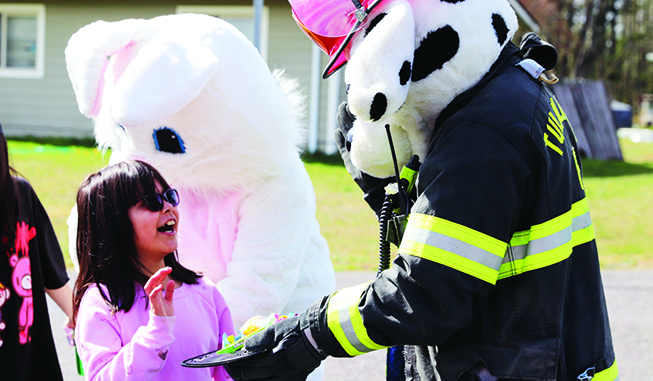
By Kalvin Valdillez, Tulalip News
With a pocket full of treats and sweets and an armful of plastic Easter eggs, a local kid from Tulalip beamed with excitement on the afternoon of April 2. Still in awe from a visit with the Easter Bunny, the young man’s mom spoke on his behalf, “He told me this is the best Easter ever! He met the Easter Bunny and gave him a hug.” As the mother and son made their way back to their home, the boy looked behind his shoulder every now and again, stealing glances at the Easter Bunny, in hopes of giving him one last wave as the bunny continued his tour through Tulalip.
“It’s always good to see the joy on the kids’ faces, and the parents too. They are happy to see that their children are being thought about in our community,” shared Malory Simpson, Founder of Together We’re Better, the local non-profit that organizes the yearly Easter Run.
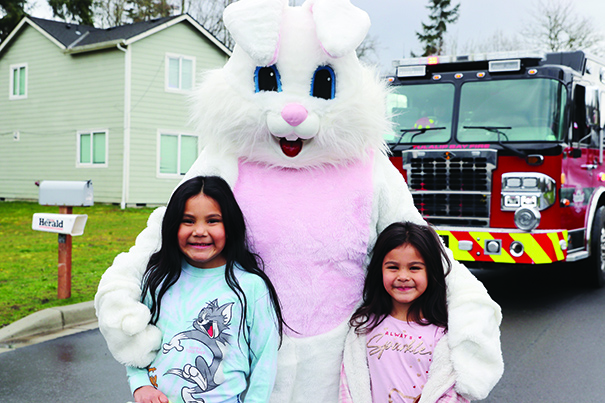
Time and time again, as the Easter Bunny arrived at different neighborhoods of the reservation, children jumped with joy, and many of the kids ran to the bunny with their arms wide open to receive a big hug from the loveable character.
Together We’re Better has been delivering smiles across the reservation over the past decade. Every year the organization hosts a number of fun community-based events, such as the ever-popular Halloween gathering Trunk or Treat.
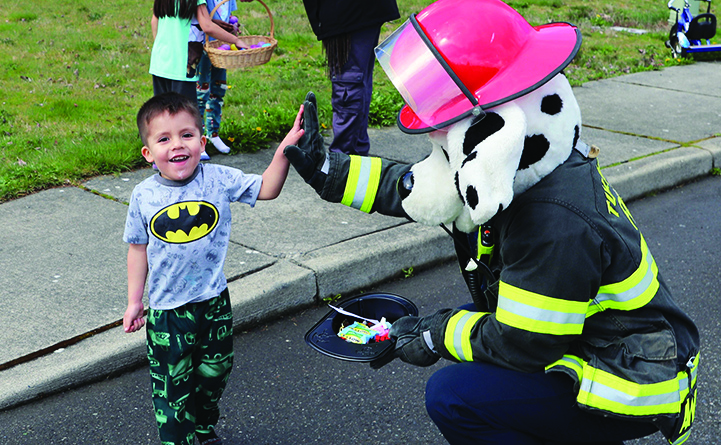
One of the many good things about Together We’re Better is the fact that each of their events has amazing turnouts and unites hundreds of Tulalip brethren together for a good time. And between the number of volunteers who commit to working the events and all the donations of food, candy, toys, and sometimes cash, it goes without saying that Together We’re Better is for the community, by the community.
Malory expressed, “Giving back to the community always feels really good. This is all community effort, so all of the donations were by Tribal members – Tribal members who are putting time and effort into stuffing eggs and buying prizes. Bags of candy were [regularly] dropped off on my porch. It makes my heart happy to see the community coming together to take care of each other.”
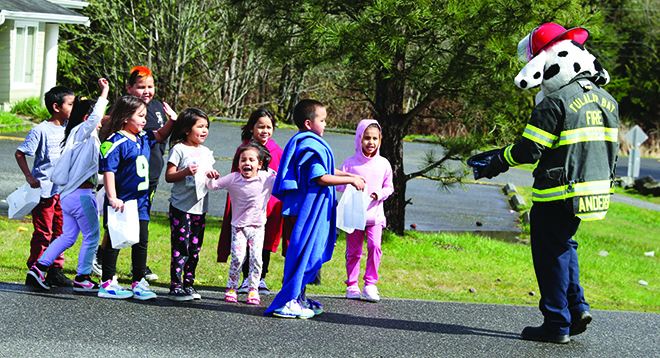
The Easter Run is a fairly new event, and this was the third year that Together We’re Better held the springtime celebration. In previous years, the organization hosted an Easter egg hunt for the people of Tulalip. However, the non-profit made the pivot to the Easter Run during the worldwide pandemic to eliminate the threat of spreading the virus.
Malory recalled that despite COVID, she wanted to continue with an Easter event, and she was inspired by the Tulalip Bay Fire Department’s annual Santa Run. The kids and families who live within the Fire Department’s district look forward to the Santa Run each year for a chance to meet St. Nick and also to donate non-perishable goods to the food bank at the Tulalip Church of God.
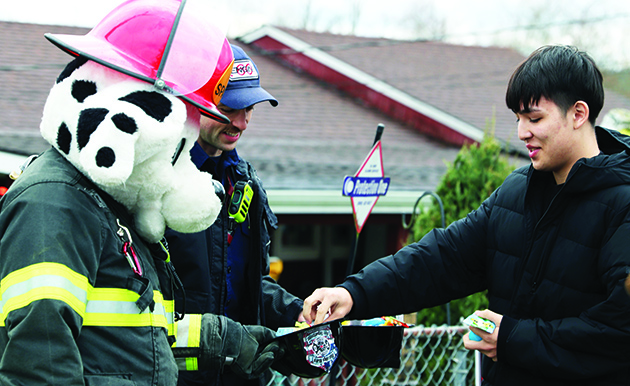
Malory reached out to Tulalip Bay Fire and formed a partnership with the department. So, in addition to the volunteers of Together We’re Better, several volunteer firemen join in on the fun and help deliver goodies to the kids every Easter. And as an added bonus, the fire department recruits the nationally known fire prevention mascot, Sparky the Fire Dog, who dishes out high-fives and daps a plenty to the children during the Easter Run.
Captain Shockley of the local fire crew stated, “We’re always eager for any opportunity to get out and create a positive impact, and to have more of that human connection with everybody in our community. It’s a great way to see all the kids and all the extended families. We’ve been doing the Santa Run for many years, and the Easter Run is another way for us to get out and show our faces more. It’s important for us to build those relationships because at times, we show up on not the best day for a lot of families. And if we’ve already formed those relationships of trust, that’s huge for us. And also, we love taking part in an ongoing positive event.”
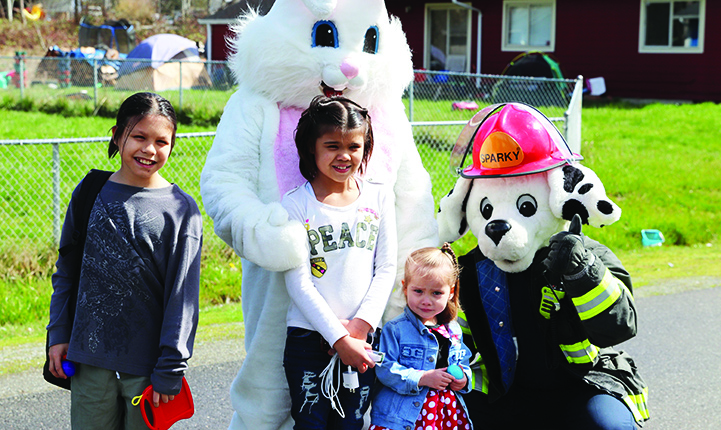
The Easter Run has become so popular that Together We’re Better has decided to stick with the event, even after gathering limitations were lifted on the reservation. And with all the smiles displayed on the little one’s faces over the years, it’s easy to see why the non-profit made that call.
Throughout the day, the group of volunteers walked the Y-Site, Battlecreek, Larry Price/Ezra Hatch, Silver Village, and Mission Highlands neighborhoods. They delivered Easter eggs to well over one hundred children. The Easter Run is quickly becoming one of the more popular events at Tulalip, and after each visit, the children are sure to leave with a good amount of treats and happy memories.
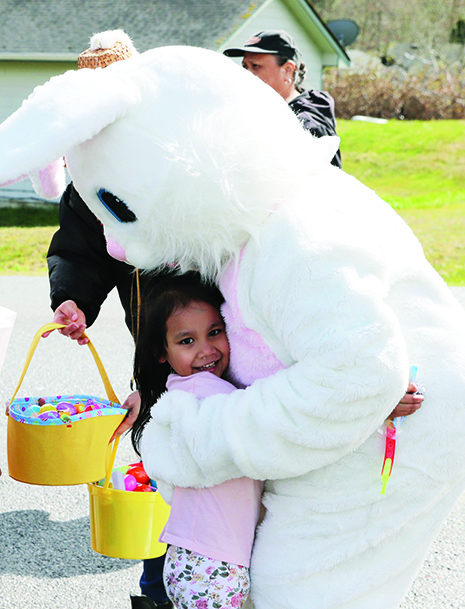
“I just love it,” Malory exclaimed. “Their smiles and laughter make you feel really good inside. Just seeing their excitement was one of the best things about the event today. It’s pretty fun to see all of their reactions and see how happy the kids are to spend some time with the Easter Bunny and Sparky the Dalmatian.”
If you are looking to get more involved with the community, Together We’re Better is always accepting donations, whether it’s goods, funds, or your personally volunteered time. For more information, please contact Malory at (360) 913-1424.